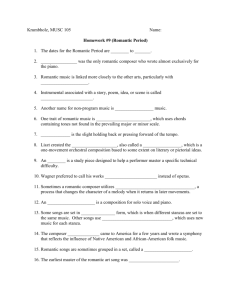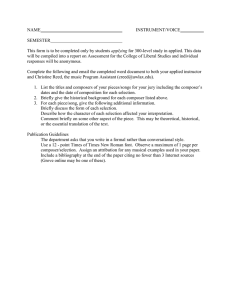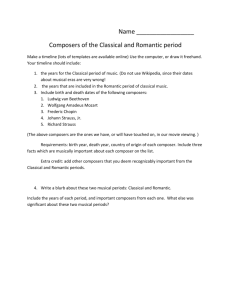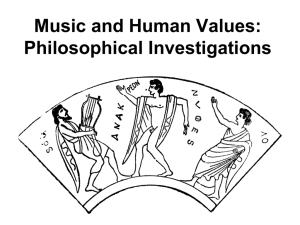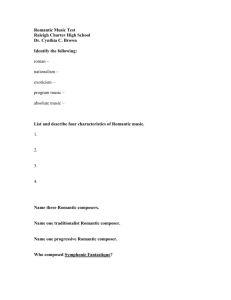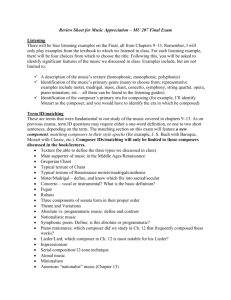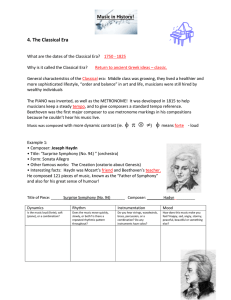Creative Listening 1306 Study Guide IV
advertisement
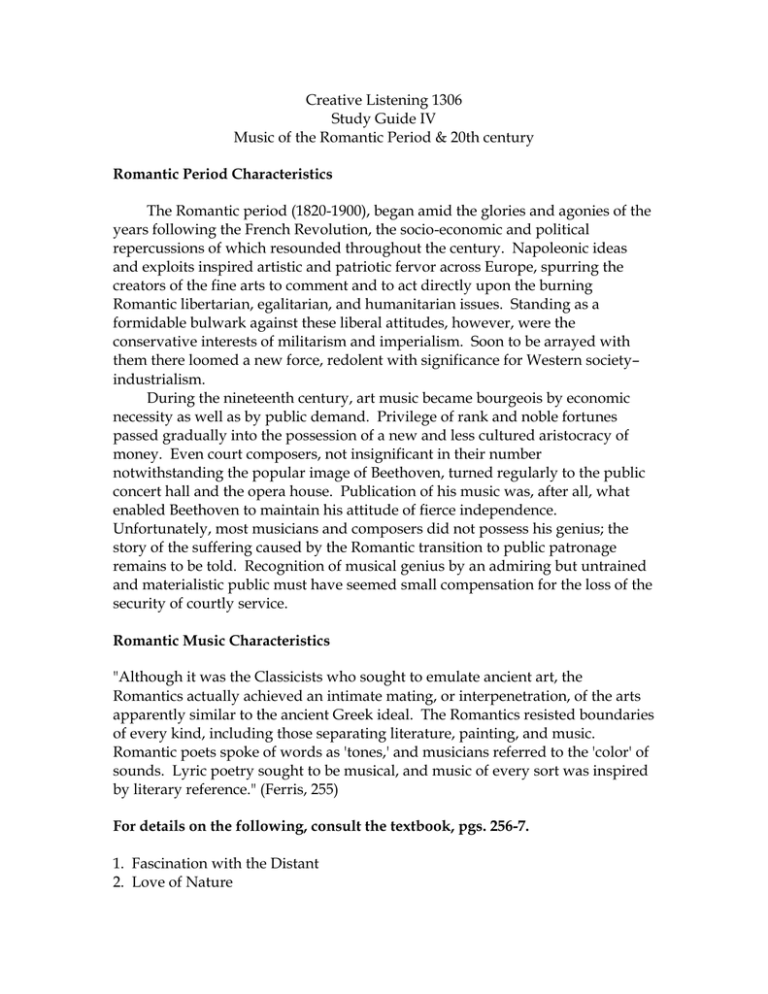
Creative Listening 1306 Study Guide IV Music of the Romantic Period & 20th century Romantic Period Characteristics The Romantic period (1820-1900), began amid the glories and agonies of the years following the French Revolution, the socio-economic and political repercussions of which resounded throughout the century. Napoleonic ideas and exploits inspired artistic and patriotic fervor across Europe, spurring the creators of the fine arts to comment and to act directly upon the burning Romantic libertarian, egalitarian, and humanitarian issues. Standing as a formidable bulwark against these liberal attitudes, however, were the conservative interests of militarism and imperialism. Soon to be arrayed with them there loomed a new force, redolent with significance for Western society– industrialism. During the nineteenth century, art music became bourgeois by economic necessity as well as by public demand. Privilege of rank and noble fortunes passed gradually into the possession of a new and less cultured aristocracy of money. Even court composers, not insignificant in their number notwithstanding the popular image of Beethoven, turned regularly to the public concert hall and the opera house. Publication of his music was, after all, what enabled Beethoven to maintain his attitude of fierce independence. Unfortunately, most musicians and composers did not possess his genius; the story of the suffering caused by the Romantic transition to public patronage remains to be told. Recognition of musical genius by an admiring but untrained and materialistic public must have seemed small compensation for the loss of the security of courtly service. Romantic Music Characteristics "Although it was the Classicists who sought to emulate ancient art, the Romantics actually achieved an intimate mating, or interpenetration, of the arts apparently similar to the ancient Greek ideal. The Romantics resisted boundaries of every kind, including those separating literature, painting, and music. Romantic poets spoke of words as 'tones,' and musicians referred to the 'color' of sounds. Lyric poetry sought to be musical, and music of every sort was inspired by literary reference." (Ferris, 255) For details on the following, consult the textbook, pgs. 256-7. 1. Fascination with the Distant 2. Love of Nature 3. Revolutionary Spirit 4. Art for Art's Sake 5. Nationalism & Internationalism Ludwig van Beethoven (1770-1827) Beethoven was "one of the great disruptive forces in the history of music" (Grout, A History of Western Music); he opened new pathways that were followed by other Romantic composers, among them the use of cyclic and programmatic elements, expansion of the orchestra, introduction of chorus and text into the symphony, and writing out the concerto cadenza. He brought new status to musicians by his proud independence and his ability to earn his own way through publication. He expanded classical sonata allegro form, embraced greater contrasts, changed the traditional number and order of movements, spanned wider tonal relationships, added a coda as a major element of structure, and successfully introduced many other innovations. Sonatas: more that 32 for piano, 10 for violin, 5 for violoncello Chamber music: 16 string quartets, 3 string quintets a septet, 9 piano trios Orchestral music: 9 symphonies, 11 overtures Concerti: 5 for piano, 1 for violin, and 1 for piano, violin, and violoncello Other Romantic composers: Franz Schubert (1797-1828) Ger. •Transitional composer •Only "Viennese"composer who was actually from Vienna •Known for his German Art Songs (leider) •His symphonies were classical in form but Romantic in content & expression. •Composer of "Erlköning" and "Gretchen am Spinnrade" Hector Berlioz ((1803-69) Fr. •Great orchestrator •Used "Idee Fixe" or Fixed Idea •Wrote program symphony "Symphonie Fantastique." Peter Tchaikovsky (1840-93) Russ. •Strongly influenced by the West •composer of classical Russian ballet: "Sleeping Beauty", "Nutcracker," and "Swan Lake." •Composer of Concert Overtures such as "Overture of 1812." Frederic Chopin (1810-49) Pol. •composer of piano music •utilized Polish folk music and dance in his compositions of "mazurkas" and "polanaise." •His paino character piece include: nocturnes, impromptus, ballades, and preludes. Richard Wagner (1813-1883) Ger. •German nationalist politician and musician •Envisioned a form of music theatre in which the words and music were of equal importance-Music Drama. •His music dramas often relied on "supernatural intervention," not realistic human situations. •Composed the "Ring of the Nibelung" "Music of the Future." •Utilized "Leitmotifs-music fragments or melodies that gave reference to a particular person, event, or idea. Often introduced in the orchestra. Giuseppe Verdi (1813-1901) It. •Italian nationalist politician and composer •Greatest opera composer of the period. •Anti-Wagnerian •Composer of "Otello" and "Falstaff." Giacomo Puccini (1858-1924) It. •Portrayed realistic, everyday characters in his operas. This realism or naturalism is referred to as "verismo." (truth) •Composer of "La Bohème" and "Madama Butterfly." Johannes Brahms (1822-97) Ger. •Based his music upon models from the past. •Emulated Bach, Mozart,Haydn, and Schubert. •Loved Beethoven-Brahms first symphony is sometimes called Beethoven's Tenth Other Nationalistic Composers •Bedrich Smetana (1824-84) Czech. "The Moldau." •Antonin Dvorák (1841-1904) Czech. "The New World Symphony." •Edward Grieg (1843-1907) Nor. "Peer Gynt Suite." Terminology: art song The setting of a well-known poet's work to music by a serious composer. Lieder German art songs nationalism A late-19th-century movement in which artists of many nationalities turned from the dominant German influence in the arts to the cultural characteristics of their won and of other countries. program music Music organized according to literary or extra-musical ideas. Concert overture A one-movement orchestral composition, often inspired by literature and dramatic in expression, yet generally subject to analysis according to Classical principles of form. program symphony A multimovement-orchestral work, the form of which is based upon programmatic concepts. symphonic or tone poem A one-movement orchestral piece, the form of which is based upon programmatic principles. absolute music Instrumental music based upon abstract principles of music theory and form. Twentieth Century Music Only in an "age of technology", could music become principally a commodity; but only an "age of anxiety" careening between two world wars and economic depressions would saturate its aural environment with electrically transmitted sound separated from sense. A state of world-weariness (Weltschmerz) inherited from the decaying Romantic world characterized many Western artists in the early 20th century, perhaps as a result of a conflict between their humanitarian ideals and a ruthlessly profit-minded society. About mid-century, composers faced a more fundamental dilemma that threatened their relationship with an already much-diminished public: philosophical, theoretical, and stylistic developments in the realm of sound and rhythm seemed to demand redefinition of the art of music. General (very) characteristics of 20th-century music Melody Melody becomes less important. They become different and difficult to perform and recognize. Melodies are based on different types of scale forms other major/minor forms such as pentatonic (five-note scale), whole tone scale, atonality/12-tone melodies , and scale forms from non-western cultures. Harmony A renewed interest in Medieval modes, chords based on intervals other than thirds are used (4ths & 5ths). Chords are used for their color rather than function. Bi-tonality becomes popular. Timbre Old instruments become popular. String instruments become less popular. Brass and percussion is used for color effects. Non-western percussion is used as well as the human voice as color instruments. Instruments are used in non-traditional ways in order for the composer to achieve the effect so desired. Texture A renewal of polyphony. Polyrhythms are used as are heterogeneous ensembles. Terminology Impressionism A style of painting and of music that avoids explicit statement, instead emphasizing suggestion and atmosphere. A French generated movement with composer Claude Debussy as it's main proponent. Impressionist music is characterized by parallel chord movement, unresolved dissonance, whole-tone scales, and subtle, unusual color effects as was heard in Debussy's Prélude à l'après-midi d'un Faune (Prelude to the afternoon of a Faun). Expressionism A highly emotional style that sought to express disturbed states of the mind. The term is borrowed from art history to describe German composers , namely Arnold Schoenberg, who shared a deeply subjective approach to their craft. Primitivism A style inspired by primitive works of art and by the relaxed life of uncivilized cultures. The characteristics include strong, "savage" rhythms, dissonant combinations of sound, narrow melodies. The masterpiece of music in the Primitive style is Le Sacre du Printemps (The Rite of Spring). atonality The avoidance of a tonic note and of tonal relationships in music. sprechstimme Literally "speech voice." A style of melodramatic declamation between speaking and singing. Often found in expressionistic music. bi-tonality When two keys are employed simultaneously. electronic music Compositions produced exclusively by electronic means as well some that include both electronic and natural sounds. Listening Example: CD Disc 2 (track 14)–Symphony No. 5, Beethoven CD Disc 2 (track 24)–Erlkönig–Franz Schubert CD Disc 2 (track 32)–Symphonie Fantastique–Hector Berlioz CD Disc 2 (track 38)–Polonaise in A-flat–Frederic Chopin CD Disc 2 (track52)–Prelude to the Afternoon of a Faun–Claude Debussy CD Disc 2 (track 56)–The Rite of Spring –Igor Stravinsky CD Disc 2 (track 48 )–"Mondestrunken"–Arnold Schoenberg CD Disc 3 (track 7)–The Banshee–Henry Cowell
